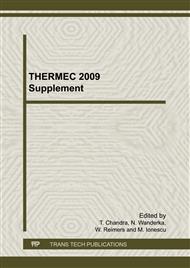p.709
p.715
p.721
p.727
p.733
p.739
p.745
p.751
p.757
Grain Boundary Modification by Si3N4 Additions and the Effect on Corrosion Behaviors in Two Sintered Nd-Fe-B Magnets
Abstract:
Two sintered magnets Nd15Dy1.2Fe77Al0.8B6 and Nd22Fe71B7 were modified by intergranular additions of Si3N4. The remanence as well as sintering density of the two magnets increased slightly with appropriate amount of Si3N4 additives. Meanwhile, there was an obvious increase in coercivity of the Nd-rich Nd22Fe71B7 magnet after 0.3 wt. % Si3N4 was added to magnets. Besides the effects on magnetic properties, an improved corrosion resistance was observed. Compared with the native magnets without any additions, corrosion potential of the magnets with Si3N4 additives is more positive and the current density in the anodic branch of the polarization curve is reduced. Microstructure observation reveals that Si3N4 additives have been incorporated into the intergranular phases in the magnets. Si is found to enrich in the Nd-rich intergranular phase with low oxygen content. With the introduction of Si3N4 additives, more intergranular phase with high oxygen content is formed, which may contribute to improved corrosion resistance. In addition, addition of Si3N4 refines the grain size of Nd22Fe71B7.
Info:
Periodical:
Pages:
733-738
Citation:
Online since:
January 2010
Authors:
Price:
Сopyright:
© 2010 Trans Tech Publications Ltd. All Rights Reserved
Share:
Citation:


